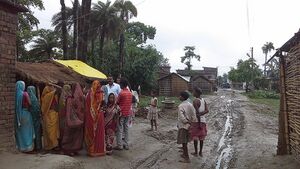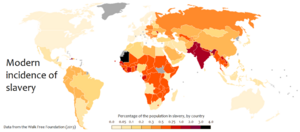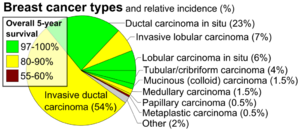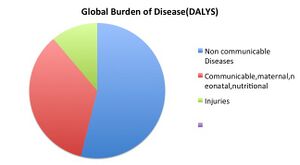Epidemiology, Prevalence and Incidence: Difference between revisions
Rachael Lowe (talk | contribs) mNo edit summary |
m (Changed protection settings for "Epidemiology, Prevalence and Incidence" ([Edit=⧼protect-level-volunteer⧽] (indefinite) [Move=⧼protect-level-volunteer⧽] (indefinite))) |
||
| (24 intermediate revisions by 8 users not shown) | |||
| Line 1: | Line 1: | ||
<div class="editorbox"> | <div class="editorbox"> | ||
'''Original Editor '''- | '''Original Editor '''- [[User:Rachael Lowe|Rachael Lowe]] | ||
'''Top Contributors''' - {{Special:Contributors/{{FULLPAGENAME}}}} | '''Top Contributors''' - {{Special:Contributors/{{FULLPAGENAME}}}} | ||
</div> | </div> | ||
== Epidemiology == | == Epidemiology == | ||
[[File:Outbreak Investigation - India.jpeg|right|frameless]] | |||
</ref><blockquote>''Epidemiology is the study of the distribution and determinants of health-related states or events in specified populations, and the application of this study to the control of health problems''<ref name=":2">Last JM, editor. Dictionary of epidemiology. 4th ed. New York: Oxford University Press; 2001.</ref></blockquote> | Epidemiology is the branch of medical science that investigates all the factors that determine the presence or absence of diseases and disorders. Epidemiological research helps us to understand how many people have a disease or disorder, if those numbers are changing, and how the disorder affects our society and our economy.<ref>NIH [https://www.nidcd.nih.gov/health/statistics/what-epidemiology What Is Epidemiology?] Available from:https://www.nidcd.nih.gov/health/statistics/what-epidemiology (accessed 19.8.2021)</ref> Epidemiology is often described as the basic science of public health.<ref name=":1">Introduction to Epidemiology. Lesson 1 in: Centers for Disease Control and Prevention. Principles of Epidemiology in Public Health Practice, An Introduction to Applied Epidemiology and Biostatistics. [https://www.cdc.gov/OPHSS/CSELS/DSEPD/SS1978/Lesson1/Section1.html#_ref1 https://www.cdc.gov/OPHSS/CSELS/DSEPD/SS1978/Lesson1/Section1.html] (accessed 28 August 2017) | ||
</ref>Image 1: a disease outbreak investigation.<blockquote>''Epidemiology is the study of the distribution and determinants of health-related states or events in specified populations, and the application of this study to the control of health problems''<ref name=":2">Last JM, editor. Dictionary of epidemiology. 4th ed. New York: Oxford University Press; 2001.</ref></blockquote> | |||
''' | == Key Terms == | ||
[[File:Incidence of slavery.png|right|frameless]] | |||
'''Incidence''': The number of new cases of a disease or disorder in a population over a period of time. An example of incidence: Auckland in New Zealand, often has epidemics of meningococcal disease, with annual incidences of up to 16.9/ 100,000 people.<ref name=":02">Linda Shields and Alison Twycross, the difference between incidence and prevalence, vol 15 no 7 September 2003.</ref> | |||
[[File:Pie chart of incidence and prognosis of histopathologic breast cancer types.png|right|frameless]] | |||
'''Prevalence''': The number of existing cases of a disease in a population at a given time. An example of prevalence: A recent Scottish study showed that the prevalence of [[obesity]] in a group of children aged from 3 to 4 years was 12.8% at the time.<ref name=":03">Linda Shields and Alison Twycross, the difference between incidence and prevalence, vol 15 no 7 September 2003.</ref> | |||
''' | '''Cost of illness''': Many reports use expenditures on medical care (i.e., actual money spent) as the cost of illness. Ideally, the cost of illness would also take into account factors that are more difficult to measure, such as work-related costs, educational costs, the cost of support services required by the medical condition, and the amount individuals would pay to avoid health risks. | ||
The disability-adjusted life year (DALY) is a measure of overall disease burden. It was developed in the 1990s as a way of comparing the overall health and life expectancy of different countries.<ref>Study education Org. The Global Burden Of Diseases Available: https://www.studyeducation.org/study/the-global-burden-of-diseases (accessed 19.8.2021)</ref> | |||
[[File:Global burden of disease(Dalys).jpeg|right|frameless]] | |||
''' | # '''Burden of disease''': The total significance of disease for society, beyond the immediate cost of treatment. It is measured in years of life lost to ill health, or the difference between total life expectancy and disability-adjusted life expectancy (DALY). | ||
# '''DALY''' ([[Disability-Adjusted Life Year]]): A summary measure of the health of a population. One DALY represents one lost year of healthy life and is used to estimate the gap between the current health of a population and an ideal situation in which everyone in that population would live into old age in full health | |||
''' | == Important Principles of Epidemiology == | ||
'''Study''' - a scientific discipline with sound methods of scientific inquiry at its foundation. Various methods can be used to carry out epidemiological investigations: surveillance and descriptive studies can be used to study distribution; analytical studies are used to study determinants.<ref>World Health Organisation. Epidemiology. http://www.who.int/topics/epidemiology/en/ (accessed 28 August 2017)</ref> | |||
''' | '''Distribution''' - the frequency (number of health events in a population and it's relationship of that number to the size of the population - prevalence) and pattern (the occurrence of health-related events by time, place, and person - incidence) of health events in a population. | ||
'''[[Determinants of Health|Determinants]]''' - the causes and other factors that influence the occurrence of disease and other health-related events. | |||
'''Health-related states or events''' - these may include [[Communicable Diseases|communicable]] and [[Non-Communicable Diseases|non-communicable diseases,]] [[Chronic Disease|chronic diseases]], injuries, birth defects, maternal-child health, occupational health, and environmental health. More recently studies have included behaviours related to health and well-being and genetic markers of disease risk. | |||
'''Specified populations''' - the epidemiologist is concerned about the collective health of the people in a community or population<ref name=":1" />. A key feature of epidemiology is the measurement of disease outcomes in relation to a ''population at risk''.<ref name=":0">The BMJ. What is Epidemiology. Chapter 1 in: Epidemiology for the uninitiated. [http://www.bmj.com/about-bmj/resources-readers/publications/epidemiology-uninitiated/1-what-epidemiology#chapters http://www.bmj.com/about-bmj/resources-readers/publications/epidemiology-uninitiated/1-what-epidemiology] (accessed 28 August 2017)</ref> Implicit in any epidemiological investigation is the notion of a ''target population'' about which conclusions are to be drawn and are often observations that can only be made on a ''study sample'', which is selected in some way from the target population.<ref name=":0" /> | |||
'''Application''' - Epidemiology is not just “the study of” health in a population; it also involves applying the knowledge gained by the studies to community-based practice.<blockquote>Epidemiology is the study (scientific, systematic, data-driven) of the distribution (frequency, pattern) and determinants (causes, risk factors) of health-related states and events (not just diseases) in specified populations (patient is community, individuals viewed collectively), and the application of (since epidemiology is a discipline within public health) this study to the control of health problems.<ref name=":1" /></blockquote> | |||
== Incidence versus Prevalence == | == Incidence versus Prevalence == | ||
Incidence is often confused with prevalence. The easy way to remember the difference is that | Incidence is often confused with prevalence. The easy way to remember the difference is that prevalence is the proportion of cases in the population at a given time rather than rate of occurrence of new cases. Thus, incidence conveys information about the risk of contracting the disease, whereas prevalence indicates how widespread the disease is. | ||
{{#ev:youtube| | {{#ev:youtube|cTp_ONVVrh8}} | ||
{{#ev:youtube|1jzZe3ORdd8}} | {{#ev:youtube|1jzZe3ORdd8}} | ||
| Line 36: | Line 46: | ||
<references /> | <references /> | ||
[[Category:Epidemiology]] | |||
Latest revision as of 11:29, 15 November 2023
Original Editor - Rachael Lowe
Top Contributors - Rachael Lowe, Lucinda hampton, Kim Jackson, Tony Lowe, Simisola Ajeyalemi, Samuel Adedigba, Amanda Ager and Jess Bell
Epidemiology[edit | edit source]
Epidemiology is the branch of medical science that investigates all the factors that determine the presence or absence of diseases and disorders. Epidemiological research helps us to understand how many people have a disease or disorder, if those numbers are changing, and how the disorder affects our society and our economy.[1] Epidemiology is often described as the basic science of public health.[2]Image 1: a disease outbreak investigation.
Epidemiology is the study of the distribution and determinants of health-related states or events in specified populations, and the application of this study to the control of health problems[3]
Key Terms[edit | edit source]
Incidence: The number of new cases of a disease or disorder in a population over a period of time. An example of incidence: Auckland in New Zealand, often has epidemics of meningococcal disease, with annual incidences of up to 16.9/ 100,000 people.[4]
Prevalence: The number of existing cases of a disease in a population at a given time. An example of prevalence: A recent Scottish study showed that the prevalence of obesity in a group of children aged from 3 to 4 years was 12.8% at the time.[5]
Cost of illness: Many reports use expenditures on medical care (i.e., actual money spent) as the cost of illness. Ideally, the cost of illness would also take into account factors that are more difficult to measure, such as work-related costs, educational costs, the cost of support services required by the medical condition, and the amount individuals would pay to avoid health risks.
The disability-adjusted life year (DALY) is a measure of overall disease burden. It was developed in the 1990s as a way of comparing the overall health and life expectancy of different countries.[6]
- Burden of disease: The total significance of disease for society, beyond the immediate cost of treatment. It is measured in years of life lost to ill health, or the difference between total life expectancy and disability-adjusted life expectancy (DALY).
- DALY (Disability-Adjusted Life Year): A summary measure of the health of a population. One DALY represents one lost year of healthy life and is used to estimate the gap between the current health of a population and an ideal situation in which everyone in that population would live into old age in full health
Important Principles of Epidemiology[edit | edit source]
Study - a scientific discipline with sound methods of scientific inquiry at its foundation. Various methods can be used to carry out epidemiological investigations: surveillance and descriptive studies can be used to study distribution; analytical studies are used to study determinants.[7]
Distribution - the frequency (number of health events in a population and it's relationship of that number to the size of the population - prevalence) and pattern (the occurrence of health-related events by time, place, and person - incidence) of health events in a population.
Determinants - the causes and other factors that influence the occurrence of disease and other health-related events.
Health-related states or events - these may include communicable and non-communicable diseases, chronic diseases, injuries, birth defects, maternal-child health, occupational health, and environmental health. More recently studies have included behaviours related to health and well-being and genetic markers of disease risk.
Specified populations - the epidemiologist is concerned about the collective health of the people in a community or population[2]. A key feature of epidemiology is the measurement of disease outcomes in relation to a population at risk.[8] Implicit in any epidemiological investigation is the notion of a target population about which conclusions are to be drawn and are often observations that can only be made on a study sample, which is selected in some way from the target population.[8]
Application - Epidemiology is not just “the study of” health in a population; it also involves applying the knowledge gained by the studies to community-based practice.
Epidemiology is the study (scientific, systematic, data-driven) of the distribution (frequency, pattern) and determinants (causes, risk factors) of health-related states and events (not just diseases) in specified populations (patient is community, individuals viewed collectively), and the application of (since epidemiology is a discipline within public health) this study to the control of health problems.[2]
Incidence versus Prevalence[edit | edit source]
Incidence is often confused with prevalence. The easy way to remember the difference is that prevalence is the proportion of cases in the population at a given time rather than rate of occurrence of new cases. Thus, incidence conveys information about the risk of contracting the disease, whereas prevalence indicates how widespread the disease is.
References[edit | edit source]
- ↑ NIH What Is Epidemiology? Available from:https://www.nidcd.nih.gov/health/statistics/what-epidemiology (accessed 19.8.2021)
- ↑ 2.0 2.1 2.2 Introduction to Epidemiology. Lesson 1 in: Centers for Disease Control and Prevention. Principles of Epidemiology in Public Health Practice, An Introduction to Applied Epidemiology and Biostatistics. https://www.cdc.gov/OPHSS/CSELS/DSEPD/SS1978/Lesson1/Section1.html (accessed 28 August 2017)
- ↑ Last JM, editor. Dictionary of epidemiology. 4th ed. New York: Oxford University Press; 2001.
- ↑ Linda Shields and Alison Twycross, the difference between incidence and prevalence, vol 15 no 7 September 2003.
- ↑ Linda Shields and Alison Twycross, the difference between incidence and prevalence, vol 15 no 7 September 2003.
- ↑ Study education Org. The Global Burden Of Diseases Available: https://www.studyeducation.org/study/the-global-burden-of-diseases (accessed 19.8.2021)
- ↑ World Health Organisation. Epidemiology. http://www.who.int/topics/epidemiology/en/ (accessed 28 August 2017)
- ↑ 8.0 8.1 The BMJ. What is Epidemiology. Chapter 1 in: Epidemiology for the uninitiated. http://www.bmj.com/about-bmj/resources-readers/publications/epidemiology-uninitiated/1-what-epidemiology (accessed 28 August 2017)










